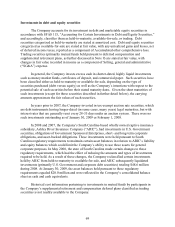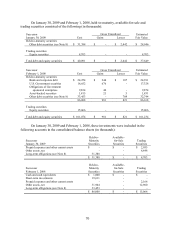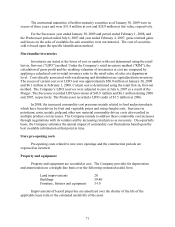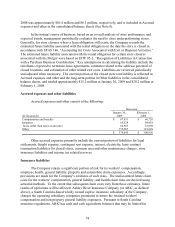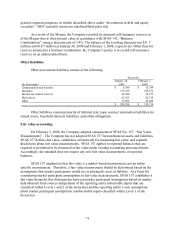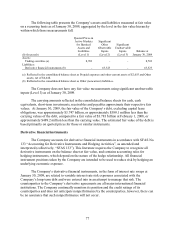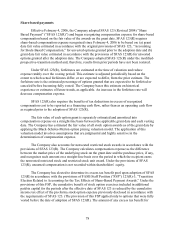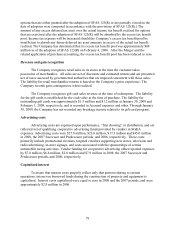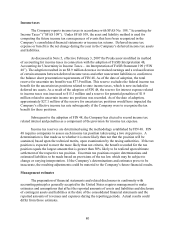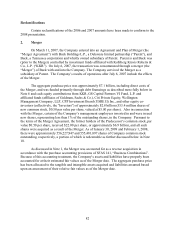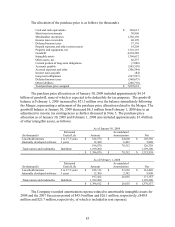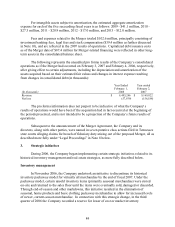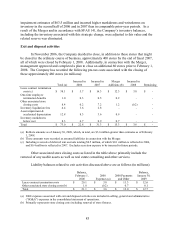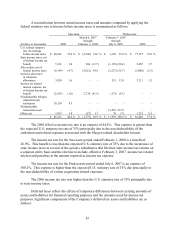Dollar General 2008 Annual Report Download - page 80
Download and view the complete annual report
Please find page 80 of the 2008 Dollar General annual report below. You can navigate through the pages in the report by either clicking on the pages listed below, or by using the keyword search tool below to find specific information within the annual report.78
Share-based payments
Effective February 4, 2006, the Company adopted SFAS 123 (Revised 2004) “Share
Based Payment” (“SFAS 123(R)”) and began recognizing compensation expense for share-based
compensation based on the fair value of the awards on the grant date. SFAS 123(R) requires
share-based compensation expense recognized since February 4, 2006 to be based on: (a) grant
date fair value estimated in accordance with the original provisions of SFAS 123, “Accounting
for Stock-Based Compensation,” for unvested options granted prior to the adoption date and (b)
grant date fair value estimated in accordance with the provisions of SFAS 123(R) for unvested
options granted after the adoption date. The Company adopted SFAS 123(R) under the modified-
prospective-transition method and, therefore, results from prior periods have not been restated.
Under SFAS 123(R), forfeitures are estimated at the time of valuation and reduce
expense ratably over the vesting period. This estimate is adjusted periodically based on the
extent to which actual forfeitures differ, or are expected to differ, from the prior estimate. The
forfeiture rate is the estimated percentage of options granted that are expected to be forfeited or
canceled before becoming fully vested. The Company bases this estimate on historical
experience or estimates of future trends, as applicable. An increase in the forfeiture rate will
decrease compensation expense.
SFAS 123(R) also requires the benefits of tax deductions in excess of recognized
compensation cost to be reported as a financing cash flow, rather than as an operating cash flow
as required prior to the adoption of SFAS 123(R).
The fair value of each option grant is separately estimated and amortized into
compensation expense on a straight-line basis between the applicable grant date and each vesting
date. The Company has estimated the fair value of all stock option awards as of the grant date by
applying the Black-Scholes-Merton option pricing valuation model. The application of this
valuation model involves assumptions that are judgmental and highly sensitive in the
determination of compensation expense.
The Company also accounts for nonvested restricted stock awards in accordance with the
provisions of SFAS 123(R). The Company calculates compensation expense as the difference
between the market price of the underlying stock on the grant date and the purchase price, if any,
and recognizes such amount on a straight-line basis over the period in which the recipient earns
the nonvested restricted stock and restricted stock unit award. Under the provisions of SFAS
123(R), unearned compensation is not recorded within shareholders’ equity.
The Company has elected to determine its excess tax benefit pool upon adoption of SFAS
123(R) in accordance with the provisions of FASB Staff Position (“FSP”) 123(R)-3, “Transition
Election Related to Accounting for the Tax Effects of Share-Based Payment Awards.” Under the
provisions of this FSP, the cumulative benefit of stock option exercises included in additional
paid-in capital for the periods after the effective date of SFAS 123 is reduced by the cumulative
income tax effect of the pro forma stock option expense previously disclosed in accordance with
the requirements of SFAS 123. (The provision of this FSP applied only to options that were fully
vested before the date of adoption of SFAS 123(R). The amount of any excess tax benefit for



